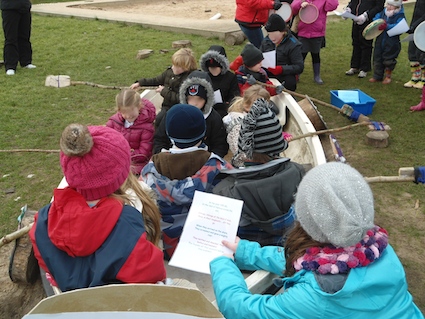
National Poetry Day is celebrated on the first Thursday in October. It is a wonderful opportunity to celebrate the power and pleasure of words. It is also an ideal introduction to writing outdoors. Here’s some ideas to get you started:
1) Make it comfortable. This blog post has suggestions about the practicalities of writing outside.
2) Explore the ideas of other poets, artists and writers. There is no need to stick to the classics either. Very often it is lesser-known people who have simple, creative adaptable ideas. For example, Gordon Young often adds humour and word play into his work as can be seen in this blog post.
3) Choose a simple structure. I have found the following work well:
- Circle Poems: No sentences, just infinitely repeatable patterns of words. This is an example of following children’s interest in a nursery
- Diamante Poems: Perfect for exploring opposites and contrasts
- Syllable Poems: Whether it’s Haikus, Tankas or even a full-blown Renga, being outside is a naturally creative space
- Simple descriptions: Look what I found? or create a Mesostic or Number Poem
- Fibonacci Poems: Use the Fibonacci Sequence as a poem structure as well as a number pattern
4) Begin with whole class or group poems where everyone contributes a line or a short verse. These can be read aloud in turn. For example, when walking outside ask children to observe what is happening outside. From here you can create a “Happen-ing Poem” where each child gives an illustration such as:
Gulls soaring
Pigeons fighting
Clouds racing
Wind gusting
A feather floating
5) Act out a poem. Very often it is an ideal way to reinforce the learning. In the photo below, a P4 class created a Viking poem which was then performed in the boat on their playing field which had been decorated as a longship.

6) Use a cuddly toy. In this blog post, the class learned a poem through a simple cuddly toy poetry walk along a path.
7) Etch a poem into a playground feature. At Inveraray Primary School, words are one medium of many for communicating their school values. Around the playground on different features, words have been carved.
8) Explore Poet-Trees. Whilst etching a poem into a tree may not be an environmentally appropriate activity, it is worth looking at the links between poems and trees. Children could lie underneath a tree and look up as you read a folk tale or story about that tree. Or simply record the words which bring to mind that can be captured through a word cloud form such as Tagxedo.
9) Hang up poems everywhere. Write short poems onto luggage tags which can be hung up in different places for everyone to discover and read when outside. This can be particularly effective when all the children in a school contribute. Think about where would work best. Sometimes just finding a poem rolled up and in a crack in a wall can be as exciting as overt public displays.
10) Create a poetry trail. Digital technology is made for this sort of thing. Transfer longer poems into QR codes to be posted around the school grounds. This can include children reciting poems. Check out this Red Rose Hunt for reading and putting together a poem.
Practical tips
- Before you begin a series of poetry sessions, ask children to write down their thoughts and beliefs about poetry. What does poetry mean to them? How much do they enjoy reading poetry? What is their experience of writing poems?
- Ask the children to choose a different place outside each week. Which place is most inspirational and why?
- Remember to take seats to sit on and spare pencils. Don’t bother with erasers. It’s rough work outside.
- Children need to practice working on their own or in pairs or a small group outside. Make the working boundary clear.
- Groups or individuals should find a space far enough away from other groups so that they can work in peace.
- Have a finishing off activity. A quiet one such as reading a book or sketching works best. Alternatively, create lots of word pebbles which can be used to play around with words, similar to magnetic poetry kits.
- Read poetry aloud to each other outside. It feels better.
- Write up a neat copy of the poem back inside. Use one piece of A5 card per poem. The children can illustrate the card afterwards. Build up a poetry journal week-on-week.
- At the end of the poetry sessions, ask children to look back at their initial thoughts about poetry. Do they still feel the same way? What have they learned through writing poems outside?
This blog post is an updated version of one originally written in September 2014.






























Hi Juliet, I met you in Sparwood, BC at the Dirty Teaching conference a few weeks ago ( hosted my CBEEN) and you had mentioned that some of your songs, like “Let’s all make a circle” were on the Blog. I can’t find them. Can you direct me to finding some of the songs that you sing to gather. Thanks! :)Anna
Hi Anna – I will message you directly as soon as I’ve checked the blog post 🙂 Thanks for getting in touch.